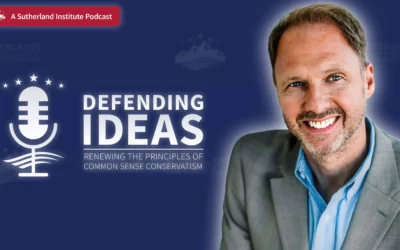
Written by Christine Cooke Fairbanks
August 31, 2023

Last week Sutherland Institute hosted an event where Rep. John Curtis and panelists spoke about the rise in political polarization.
Panelist Verlan Lewis, the Stirling Professor of Constitutional Studies at Utah Valley University, discussed the “myth” of polarization and warned against thinking about politics through the lens of a polarized, right-left spectrum.
Viewing today’s education policy issues outside of the framework of right-left politics may help us find our way forward in education reform.
The types of political polarization
To start, Lewis said that ideological polarization – in which political parties move to further policy extremes of left or right over time – is “just absolutely false.” For example, the Democratic Party once believed deeply in free speech and has since moved away from that position, but in both cases it is described as being on the “political left.” The Republican Party, on the other hand, has moved from seeking to reduce government spending and debt to embracing them when it comes to entitlement programs, but it is considered to be on the “political right” in both instances. That is logically nonsensical.
However, Lewis says that affective polarization – which means that people are more distrustful and angry toward those whose partisan affiliation differs from their own – is absolutely true and backed up by survey data.
This is the lived experience of many Americans, who feel a rise in contention over a variety of policy issues, including education policy. Battles over what is taught regarding gender, race, curriculum transparency, and parental rights have increased. Some families are making new education choices as a result.
The term affective polarization helps describe that genuine experience.
How the term “polarization” affects our thinking
But one of Lewis’ key arguments is that the term “polarization” creates an unhelpful paradigm for thinking about politics. Lewis said:
[W]hat I’ll be trying to argue is that we actually probably shouldn’t be using the term polarization, because it assumes that there are two poles on a unidimensional political spectrum that I think doesn’t exist.
And by using the term polarization, we’re actually reifying the myth that there’s only one issue in politics, there’s a unidimensional spectrum, and that all the issue positions that currently fly under the banner of the Republican Party are bound together by a unifying philosophy, and all the issue positions that currently fly under the banner of the Democratic Party fly under a common philosophy. I think that is a myth.
And I think by using the language ‘polarization’ we’re actually entrenching it. It is a self-fulfilling prophecy. We are causing people to start thinking about politics in that way.
How the polarization paradigm impacts education policy
Lewis’s argument against the polarization paradigm makes sense when looking at education policy.
Education policy ought to be a broad and unifying endeavor. The justification for the state being involved in education in the first place is that we hope all students have access to an education fitted and meaningful to them.
But for too long education reformers have viewed education policy on the unidimensional spectrum that Lewis describes, with public schooling as one pole and private schooling on the other.
Viewed this way, public education – delivered by public employees in state-funded buildings – is necessarily diminished by students who choose to go to private schools or home-school. Looking at the issue from the other side of the unidimensional spectrum, private- and home-schoolers are harmed by a substandard public school system that is falsely viewed as “free” because it is paid for largely with their taxes in addition to the tuition or expenses they pay for their own schooling.
These problematic views are compounded by how reformers talk about education choice, which gives public funds to families to be used for private education. Because public funds come from a finite pool, funds given to private schools or entities through vouchers or education savings accounts are perceived as taking away funding from public schools.
However, viewing education policy – and specifically education choice — this way perpetuates a false dichotomy about educating the public. Public education ought to mean a commitment to educating all school-age children rather than simply a system or network of district or charter schools. In this way, educating the public can include a variety of approaches or options.
A unidimensional framework with two opposing poles keeps us from viewing education in this expansive way. It prevents us from embracing education choice as part of our commitment to educate the next generation or seeing the value in public schools in general when we ourselves choose something else.
How to move forward
Luckily, the tides are shifting in some education policy discussions. New demographics are increasingly choosing alternatives to the traditional district school. (For instance, an increasing percentage of black and Hispanic families are home-schooling.) Many states are enacting laws that would give public funds to families who want to choose a private school, home school or microschool. All of this movement is likely to create new coalitions for different education policy approaches. Private education with public dollars has made inroads and seems likely to remain an education policy fixture for the foreseeable future.
To make all options work as well as possible for those who choose them, we should rethink the current paradigms.
To avoid the pitfalls of viewing education on a spectrum of polarization – the you-versus-me mentality – we can change how we discuss education reform. We can speak about education choice as a concept that includes the best public and private options, not to diminish or run away from public schools.
We can move toward commonsense ideas we support, without casting a suspicious eye on the issue simply because the opposing party also agrees.
Without a focus on polarization, we can choose to view education as a broad and noble goal that has as many paths forward as there are individual children.

Insights: analysis, research, and informed commentary from Sutherland experts. For elected officials and public policy professionals.

-
Ideological polarization looks at how policy or political positions diverge, while affective polarization describes how people feel distrustful or angry with those who have opposing opinions.
-
Overusing the term polarization may reinforce a framework of left-right politics that prevents us from seeing multiple paths forward, especially in education.
-
We should consider the commitment to educate the school-age children of the public with a wider lens than that of left-right politics so we can offer the broadest range of options to students.
Read More
How much money did the top ten ranking high schools spend per student?
Research suggests that the issue is complicated, that money does matter for school performance, and how it’s spent matters a great deal.
Why we need to fix Social Security within 10 years
On this episode we sit down with an expert to dispel some of the myths about the state of retirement today and offer a framework for how to fix Social Security before it’s too late.
Conservatives’ Golden Opportunity to Win the Minimum-Wage Argument
Election year offers conservatives an opportunity to deliver a pro-worker message that can win over persuadables on the minimum-wage debate.


